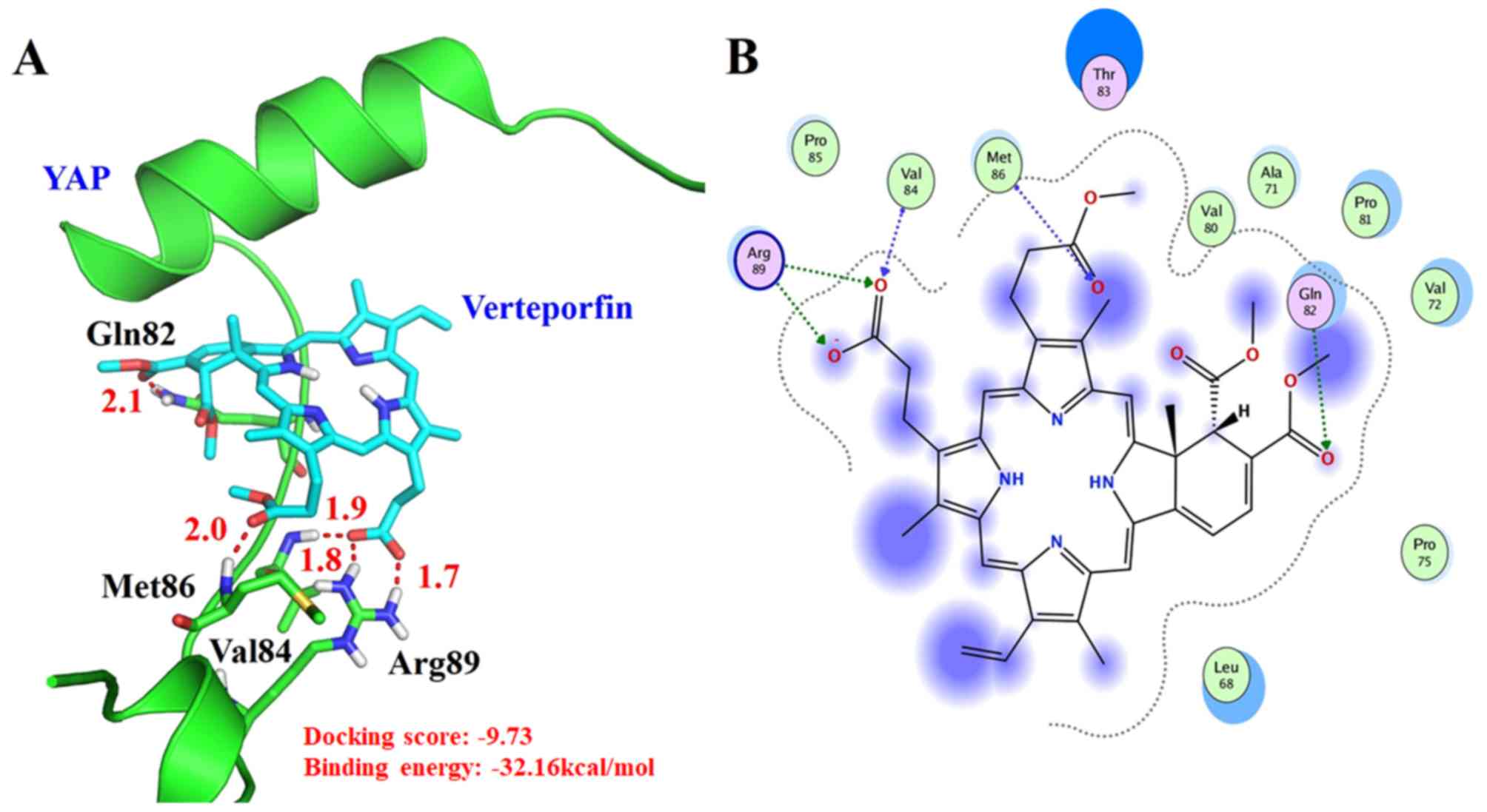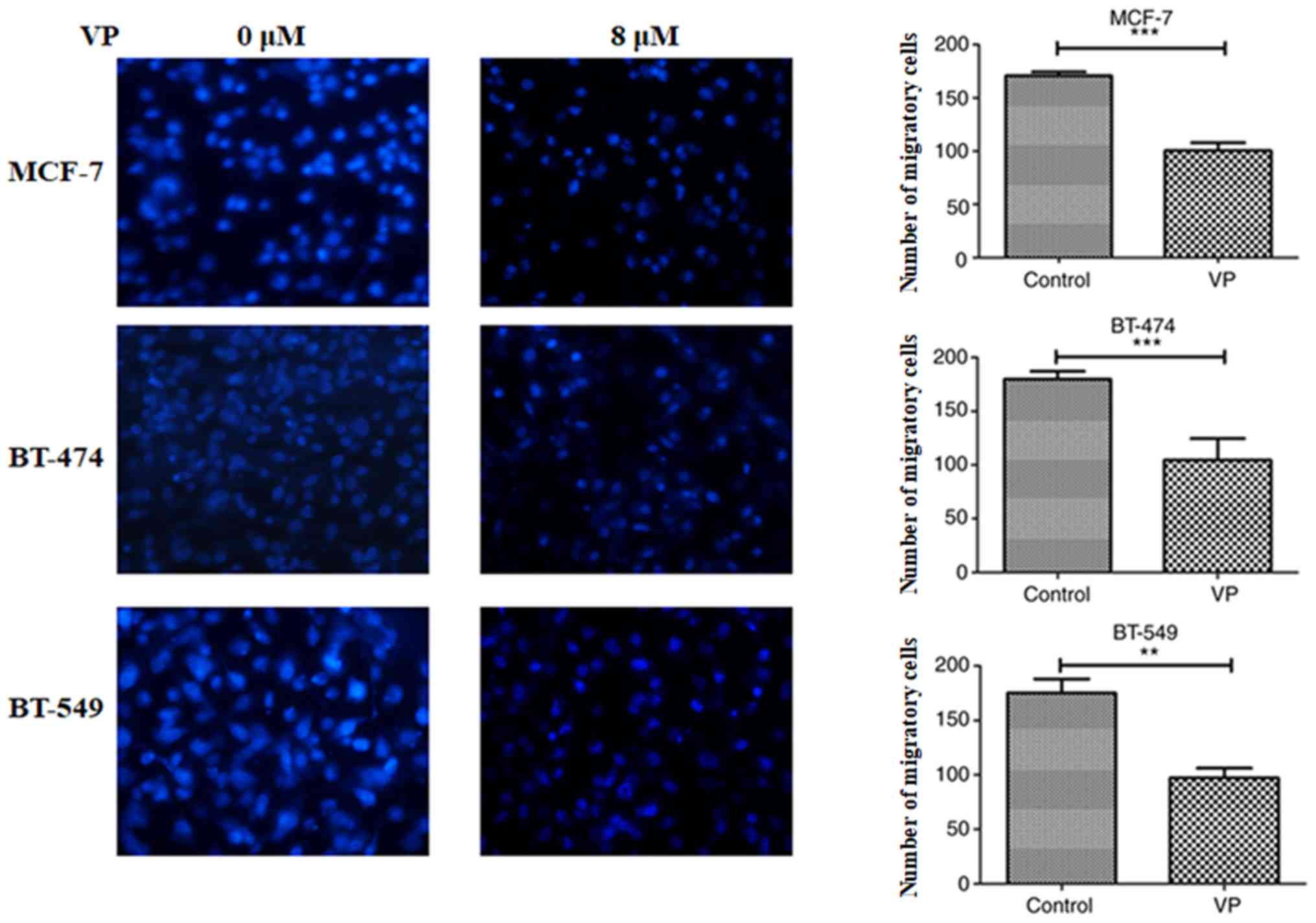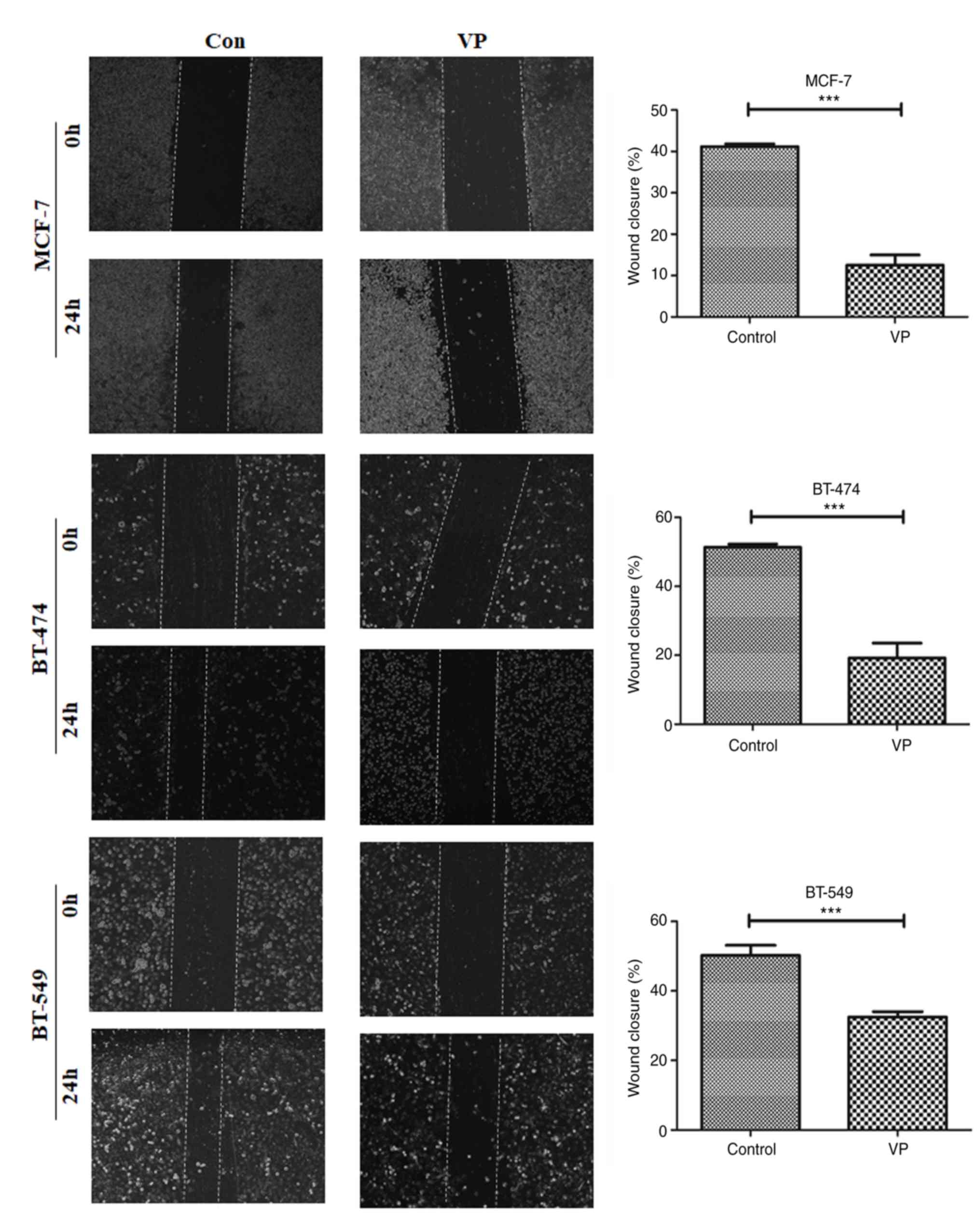|
1
|
Fu V, Plouffe SW and Guan KL: The Hippo
pathway in organ development, homeostasis, and regeneration. Curr
Opin Cell Biol. 49:99–107. 2017. View Article : Google Scholar : PubMed/NCBI
|
|
2
|
Holden JK and Cunningham CN: Targeting the
hippo pathway and cancer through the TEAD family of transcription
factors. Cancers (Basel). 10:812018. View Article : Google Scholar
|
|
3
|
Xie D, Nakachi K, Wang H, Elashoff R and
Koeffler HP: Elevated levels of connective tissue growth factor,
WISP-1, and CYR61 in primary breast cancers associated with more
advanced features. Cancer Res. 61:8917–8923. 2001.PubMed/NCBI
|
|
4
|
Luo XL, Yan Q, Tao DD, Hu JB, Li ZM, Li XL
and Gong JP: Effects of MST1 on cell proliferation and apoptosis of
human carcinoma cell line MCF-7. Tumor. 28:852–854. 2008.
|
|
5
|
Chen Q, Zhang N, Gray RS, Li H, Ewald AJ,
Zahnow CA and Pan D: A temporal requirement for Hippo signalling in
mammary gland differentiation, growth and tumorigenesis. Genes Dev.
28:432–437. 2014. View Article : Google Scholar : PubMed/NCBI
|
|
6
|
Heidary Arash E, Shiban A, Song S and
Attisano L: MARK4 inhibits Hippo signaling to promote proliferation
and migration of breast cancer cells. EMBO Rep. 18:420–436. 2017.
View Article : Google Scholar : PubMed/NCBI
|
|
7
|
Scott LJ and Goa KL: Verteporfin. Drugs
Aging. 16:139–146; discussion 147–148. 2000. View Article : Google Scholar : PubMed/NCBI
|
|
8
|
Richter AM, Waterfield E, Jain AK, Allison
B, Sternberg ED, Dolphin D and Levy JG: Photosensitising potency of
structural analogues of benzoporphyrin derivative (BPD) in a mouse
tumour model. Br J Cancer. 63:87–93. 1991. View Article : Google Scholar : PubMed/NCBI
|
|
9
|
Ziemssen F and Heimann H: Evaluation of
verteporfin pharmakokinetics-redefining the need of
photosensitizers in ophthalmology. Expert Opin Drug Metab Toxicol.
8:1023–1041. 2012. View Article : Google Scholar : PubMed/NCBI
|
|
10
|
Liu-Chittenden Y, Huang B, Shim JS, Chen
Q, Lee SJ, Anders RA, Liu JO and Pan D: Genetic and pharmacological
disruption of the TEAD-YAP complex suppresses the oncogenic
activity of YAP. Genes Dev. 26:1300–1305. 2012. View Article : Google Scholar : PubMed/NCBI
|
|
11
|
Plouffe SW, Hong AW and Guan KL: Disease
implications of the Hippo/YAP pathway. Trends Mol Med. 21:212–222.
2015. View Article : Google Scholar : PubMed/NCBI
|
|
12
|
Santucci M, Vignudelli T, Ferrari S, Mor
M, Scalvini L, Bolognesi ML, Uliassi E and Costi MP: The hippo
pathway and YAP/TAZ-TEAD protein-protein interaction as targets for
regenerative medicine and cancer treatment. J Med Chem.
58:4857–4873. 2015. View Article : Google Scholar : PubMed/NCBI
|
|
13
|
Gibault F, Corvaisier M, Bailly F, Huet G,
Melnyk P and Cotelle P: Non-photoinduced biological properties of
verteporfin. Curr Med Chem. 23:1171–1184. 2016. View Article : Google Scholar : PubMed/NCBI
|
|
14
|
Neve RM, Chin K, Fridlyand J, Yeh J,
Baehner FL, Fevr T, Clark L, Bayani N, Coppe JP, Tong F, et al: A
collection of breast cancer cell lines for the study of
functionally distinct cancer subtypes. Cancer Cell. 10:515–527.
2006. View Article : Google Scholar : PubMed/NCBI
|
|
15
|
Miller BR III, McGee TD Jr, Swails JM,
Homeyer N, Gohlke H and Roitberg AE: MMPBSA.py: An efficient
program for end-state free energy calculations. J Chem Theory
Comput. 8:3314–3321. 2012. View Article : Google Scholar : PubMed/NCBI
|
|
16
|
Berman HM, Battistuz T, Bhat TN, Bluhm WF,
Bourne PE, Burkhardt K, Feng Z, Gilliland GL, Iype L, Jain S, et
al: The protein data bank. Acta Crystallogr D Biol Crystallogr.
58((Pt 6 No 1)): 899–907. 2002. View Article : Google Scholar : PubMed/NCBI
|
|
17
|
Rostkowski M, Olsson MH, Søndergaard CR
and Jensen JH: Graphical analysis of pH-dependent properties of
proteins predicted using PROPKA. BMC Struct Biol. 11:62011.
View Article : Google Scholar : PubMed/NCBI
|
|
18
|
Yu FX, Zhao B and Guan KL: Hippo pathway
in organ size control, tissue homeostasis, and cancer. Cell.
163:811–828. 2015. View Article : Google Scholar : PubMed/NCBI
|
|
19
|
Overholtzer M, Zhang J, Smolen GA, Muir B,
Li W, Sgroi DC, Deng CX, Brugge JS and Haber DA: Transforming
properties of YAP, a candidate oncogene on the chromosome 11q22
amplicon. Proc Natl Acad Sci USA. 103:12405–12410. 2006. View Article : Google Scholar : PubMed/NCBI
|
|
20
|
Li C, Wang S, Xing Z, Lin A, Liang K, Song
J, Hu Q, Yao J, Chen Z, Park PK, et al: A ROR1-HER3-lncRNA
signalling axis modulates the Hippo-YAP pathway to regulate bone
metastasis. Nat Cell Biol. 19:106–119. 2017. View Article : Google Scholar : PubMed/NCBI
|
|
21
|
Wei H, Wang F, Wang Y, Li T, Xiu P, Zhong
J, Sun X and Li J: Verteporfin suppresses cell survival,
angiogenesis and vasculogenic mimicry of pancreatic ductal
adenocarcinoma via disrupting the YAP-TEAD complex. Cancer Sci.
108:478–487. 2017. View Article : Google Scholar : PubMed/NCBI
|
|
22
|
Dong L, Lin F, Wu W, Liu Y and Huang W:
Verteporfin inhibits YAP-induced bladder cancer cell growth and
invasion via Hippo signaling pathway. Int J Med Sci. 15:645–652.
2018. View Article : Google Scholar : PubMed/NCBI
|
|
23
|
Shi G and Wang H, Han H, Gan J and Wang H:
Verteporfin enhances the sensitivity of LOVO/TAX cells to taxol via
YAP inhibition. Exp Ther Med. 16:2751–2755. 2018.PubMed/NCBI
|
|
24
|
Harvey KF, Zhang X and Thomas DM: The
Hippo pathway and human cancer. Nat Rev Cancer. 13:246–257. 2013.
View Article : Google Scholar : PubMed/NCBI
|
|
25
|
Moroishi T, Hansen CG and Guan KL: The
emerging roles of YAP and TAZ in cancer. Nat Rev Cancer. 15:73–79.
2015. View
Article : Google Scholar : PubMed/NCBI
|
|
26
|
Mesrouze Y, Meyerhofer M, Bokhovchuk F,
Fontana P, Zimmermann C, Martin T, Delaunay C, Izaac A, Kallen J,
Schmelzle T, et al: Effect of the acylation of TEAD4 on its
interaction with co-activators YAP and TAZ. Protein Sci.
26:2399–2409. 2017. View
Article : Google Scholar : PubMed/NCBI
|
|
27
|
Pobbati AV, Han X, Hung AW, Weiguang S,
Huda N, Chen GY, Kang C, Chia CS, Luo X, Hong W, et al: Targeting
the central pocket in human transcription factor TEAD as a
potential cancer therapeutic strategy. Structure. 23:2076–2086.
2015. View Article : Google Scholar : PubMed/NCBI
|
|
28
|
Gibault F, Sturbaut M, Bailly F, Melnyk P
and Cotelle P: Targeting transcriptional enhanced associate domains
(TEADs). J Med Chem. 61:5057–5072. 2018. View Article : Google Scholar : PubMed/NCBI
|
|
29
|
Li Y, Liu S, Ng EY, Li R, Poulsen A, Hill
J, Pobbati AV, Hung AW, Hong W, Keller TH and Kang C: Structural
and ligand binding analysis of the YAP-binding domain of
transcription factor TEAD4. Biochem J. 475:2043–2055. 2018.
View Article : Google Scholar : PubMed/NCBI
|
|
30
|
Tian W, Yu J, Tomchick DR, Pan D and Luo
X: Structural and functional analysis of the YAP-binding domain of
human TEAD2. Proc Natl Acad Sci USA. 107:7293–7298. 2010.
View Article : Google Scholar : PubMed/NCBI
|
|
31
|
Lin KC, Park HW and Guan KL: Regulation of
the hippo pathway transcription factor TEAD. Trends Biochem Sci.
42:862–872. 2017. View Article : Google Scholar : PubMed/NCBI
|
|
32
|
Vlug EJ, Van De Ven RA, Vermeulen JF, Bult
P, van Diest PJ and Derksen PW: Nuclear localization of the
transcriptional coactivator YAP is associated with invasive lobular
breast cancer. Cell Oncol (Dordr). 36:375–384. 2013. View Article : Google Scholar : PubMed/NCBI
|
|
33
|
Song S, Honjo S, Jin J, Chang SS, Scott
AW, Chen Q, Kalhor N, Correa AM, Hofstetter WL, Albarracin CT, et
al: The Hippo coactivator YAP1 mediates EGFR overexpression and
confers chemoresistance in esophageal cancer. Clin Cancer Res.
21:2580–2590. 2015. View Article : Google Scholar : PubMed/NCBI
|
|
34
|
Kim J, McMillan E, Kim HS, Venkateswaran
N, Makkar G, Rodriguez-Canales J, Villalobos P, Neggers JE,
Mendiratta S, Wei S, et al: XPO1-dependent nuclear export is a
druggable vulnerability in KRAS-mutant lung cancer. Nature.
538:114–117. 2016. View Article : Google Scholar : PubMed/NCBI
|
|
35
|
Tranchant R, Quetel L, Tallet A, Meiller
C, Renier A, de Koning L, de Reynies A, Le Pimpec-Barthes F,
Zucman-Rossi J, Jaurand MC and Jean D: Co-occurring mutations of
tumor suppressor genes, LATS2 and NF2, in malignant pleural
mesothelioma. Clin Cancer Res. 23:3191–3202. 2016. View Article : Google Scholar : PubMed/NCBI
|
|
36
|
Lin C, Pelissier FA, Zhang H, Lakins J,
Weaver VM, Park C and LaBarge MA: Microenvironment rigidity
modulates responses to the HER2 receptor tyrosine kinase inhibitor
lapatinib via YAP and TAZ transcription factors. Mol Biol Cell.
26:3946–3953. 2015. View Article : Google Scholar : PubMed/NCBI
|
|
37
|
Li Y, Wang S, Wei X, Zhang S, Song Z, Chen
X and Zhang J: Role of inhibitor of yes-associated protein 1 in
triple-negative breast cancer with taxol-based chemoresistance.
Cancer Sci. 110:561–567. 2019. View Article : Google Scholar : PubMed/NCBI
|
|
38
|
Ciamporcero E, Shen H, Ramakrishnan S, Yu
Ku S, Chintala S, Shen L, Adelaiye R, Miles KM, Ullio C, Pizzimenti
S, et al: YAP activation protects urothelial cell carcinoma from
treatment-induced DNA damage. Oncogene. 35:1541–1543. 2016.
View Article : Google Scholar : PubMed/NCBI
|
|
39
|
Li W, Cao Y, Xu J, Wang Y, Li W, Wang Q,
Hu Z, Hao Y, Hu L, Sun Y, et al: YAP transcriptionally regulates
COX-2 expression and GCCSysm-4 (G-4), a dual YAP/COX-2 inhibitor,
overcomes drug resistance in colorectal cancer. J Exp Clin Cancer
Res. 36:1442017. View Article : Google Scholar : PubMed/NCBI
|
|
40
|
Yang F, Tuxhorn JA, Ressler SJ, McAlhany
SJ, Dang TD and Rowley DR: Stromal expression of connective tissue
growth factor promotes angiogenesis and prostate cancer
tumorigenesis. Cancer Res. 65:8887–8895. 2005. View Article : Google Scholar : PubMed/NCBI
|
|
41
|
Hutchenreuther J, Vincent KM, Carter DE,
Postovit LM and Leask A: CCN2 expression by tumor stroma is
required for melanoma metastasis. J Invest Dermatol. 135:2805–2813.
2015. View Article : Google Scholar : PubMed/NCBI
|
|
42
|
Li MH, Sanchez T, Pappalardo A, Lynch KR,
Hla T and Ferrer F: Induction of antiproliferative connective
tissue growth factor expression in Wilms' tumor cells by
sphingosine-1-phosphate receptor 2. Mol Cancer Res. 6:1649–1656.
2008.PubMed/NCBI
|
|
43
|
Shimo T, Kubota S, Yoshioka N, Ibaragi S,
Isowa S, Eguchi T, Sasaki A and Takigawa M: Pathogenic role of
connective tissue growth factor (CTGF/CCN2) in osteolytic
metastasis of breast cancer. J Bone Miner Res. 21:1045–1059. 2006.
View Article : Google Scholar : PubMed/NCBI
|


















